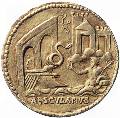The marble ship
Article Index
A) THE SHIP ORIGIN
 Since its formation (almost certainly the island has sedimentary origins and, according to the legend, it has been generated by the mud amassed on the Tarquinio il Superbo crops, thrown into the river by Romans when they expelled the king in 509 b.C.- 245 a.U.c. [ab Urbe condita = from Rome foundation]) the island had the characteristic shape of a ship that ploughs the Tiber (pict.A1). In 291 b.C.- 463 a.U.c., in order to defeat the plague of two years before, the snake sacred to the medicine god Aesculapius was brought
Since its formation (almost certainly the island has sedimentary origins and, according to the legend, it has been generated by the mud amassed on the Tarquinio il Superbo crops, thrown into the river by Romans when they expelled the king in 509 b.C.- 245 a.U.c. [ab Urbe condita = from Rome foundation]) the island had the characteristic shape of a ship that ploughs the Tiber (pict.A1). In 291 b.C.- 463 a.U.c., in order to defeat the plague of two years before, the snake sacred to the medicine god Aesculapius was brought  to Rome from Epidauro: after the landing it jumped from the ship, came down the Tiber from the Navalia of Campo Marzio (according others it swam up from the Tiberine Port or Navalia Inferiora, near the Boario Forum) up to the island, hiding in the wood in the place where the new temple was built. The Antoninus Pius medal (pict.A2) represents the snake that jumps from the rowing-ship welcome by Tiber god; the arches at the left might represent the Navalia or the Sublicio bridge.
to Rome from Epidauro: after the landing it jumped from the ship, came down the Tiber from the Navalia of Campo Marzio (according others it swam up from the Tiberine Port or Navalia Inferiora, near the Boario Forum) up to the island, hiding in the wood in the place where the new temple was built. The Antoninus Pius medal (pict.A2) represents the snake that jumps from the rowing-ship welcome by Tiber god; the arches at the left might represent the Navalia or the Sublicio bridge.
The legend and the outline of the island suggested the arrangement of the external border of the island in the shape of a ship, with embankings and earthworks suitable for moorings and perhaps with an obelisk to look like the ship-tree. This symbolic vision of the island-ship will affect in the future the cartography and the representations of the island until nowadays.
The dating of the monumental arrangement is not quite defined: Moroni states it in III century b.C., exactly in 259 b.C. - 495 a.U.c.
[...e quindi nel 495 di Roma consolidata da muri coperti di massi di travertino, fu ridotta a foggia di nave in memoria di quella che avea trasportato in essa il Dragone sagro di Esculapio.] [2]
while Donata Degrassi on "Lexicon Topographicum" dates it in I century b.C.
[L'isola... aveva già ricevuto nel I sec. a.C. una sistemazione monumentale, che le aveva conferito l'aspetto di una nave, limitatamente alle due estremità (alcuni disegni ricostruttivi del '500 la raffigurano come un'unica nave di pietra...) ...Alla struttura a valle corrispondeva probabilmente un'altra a monte, non conservata. ...In base al materiale usato nel frammento della prua, la sistemazione monumentale dell'isola va datata alla prima metà del I sec. a.C. contemporaneamente quindi all'edificazione dei due ponti...] [3]
This last dating seems to be more reliable and in accordance with the renewed pride of the Roman for their naval enterprises in the times of Pompeus Magnus.
The only remained elements are peperino [lava stone] and travertino fragments on the SouthEast end of the island representing Aesculapius with the caduceus and a bull head, probably used as mooring.
Two fragments of the obelisk that was considered the ship tree are in the National Museum of Naples and a third one in Munchen. Even if represented in many engravings it is realistic that the tree did never exist and that an obelisk, if any, has been built subsequently in the island as a simple decoration.



